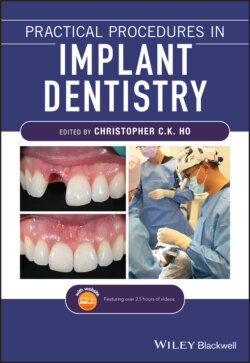Читать книгу Practical Procedures in Implant Dentistry - Группа авторов - Страница 65
7.5 Maxillary Sinus
ОглавлениеThe maxillary sinuses are among the four pairs of paranasal sinuses (frontal sinuses, sphenoid sinuses, ethmoid sinuses, and maxillary sinuses), and the only sinuses relevant to oral implantology. The maxillary sinus expands throughout childhood, with continued inferior expansion resulting in close approximation of the sinus floor to the root apices of the maxillary premolars and molars [11]. In the event of the loss of a maxillary posterior tooth, continued sinus pneumatisation inferiorly can result in inadequate bone volume for placement of a dental implant in the alveolar process or basal bone (Figure 7.3) [12].
Figure 7.3 Changes in the presentation of the maxillary sinus. (a) In the dentate subject depicted in these panoramic and cross‐sectional CBCT scan views, a significant volume of bone is maintained in the alveolar process buccally, lingually, superiorly, and even inter‐radicularly. (b) In the partially edentulous subject similarly depicted, a marked loss of the alveolar process and pneumatisation of the maxillary sinus can be observed. This has resulted in an almost uniform, eggshell‐thin layer of bone separating the maxillary sinus from the oral cavity.
The maxillary sinus in adults is a hollow pyramidal shaped space in the maxilla approximately 15 mL in volume [13], roughly 3.5 cm high × 2.4 cm wide × 3.5 cm antero‐posteriorly [14]. The sinus communicates with the nasal cavity via an opening high on the medial wall of the sinus called the ostium, which is an opening approximately 3 mm in diameter [15] in the middle meatus or space located just superior to the inferior concha.
The anterior wall of the maxillary sinus is formed by the canine fossa and is close to the infraorbital foramen. The lateral wall of the sinus is formed by the zygoma. The superior wall of the sinus is the orbital floor. The posterior wall of the sinus separates the space from the structures of the infratemporal fossa and the pterygomaxillary fossa. The inferior wall or floor of the sinus is created by the alveolar process and basal bone, as well as the hard palate.
The pyramidal shape of the maxillary sinus may be further complicated or compartmentalised by the presence of bony septa, which can cause partial division of the sinus. These septa are very common and may be found in 25–33% of sinuses [16, 17]. Although numerous variations, shapes, sizes, and locations [18] may be encountered, septa tend to have a wider base inferiorly and converge to a sharp edge superiorly.
The maxillary sinus derives its sensory innervation from branches of the maxillary nerve (CN V2) via the anterior, middle, and posterior superior alveolar nerve branches as well as the infraorbital nerve. Blood supply to the sinus stems from branches of the maxillary artery, namely the infraorbital and posterior superior alveolar arteries with some contribution additionally from the sphenopalatine and posterior lateral nasal arteries. Venous drainage of the maxillary sinus occurs via the facial vein, the pterygoid plexus, and the sphenopalatine vein.
The lining of the maxillary sinus consists of a specialised pseudostratified ciliated columnar epithelium and is called the Schneiderian membrane, which in health is usually less than 1 mm thick [19]. This complex respiratory mucosa contains specialised beaker (goblet) cells that produce mucus. The mucus traps inhaled particles, keeps the surface of the membrane moist, and serves to humidify inhaled air. The ciliated columnar epithelium provide a means of transport for the produced mucus. As a functional unit, the muco‐ciliary escalator lifts the mucus secretions and small particles up to the ostium and out to the nose.
